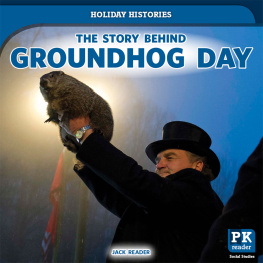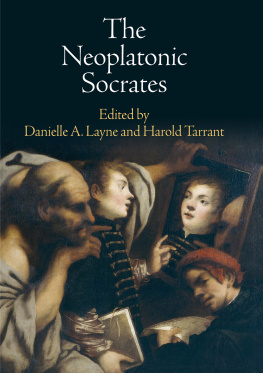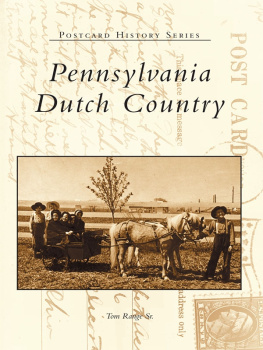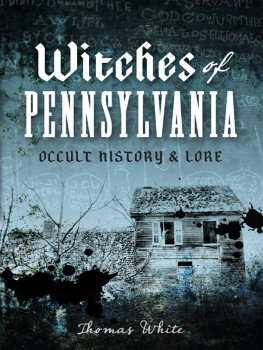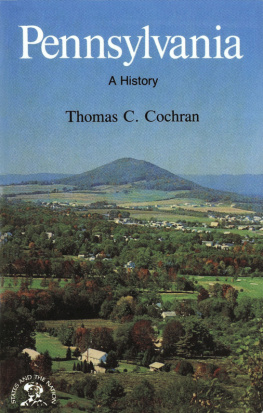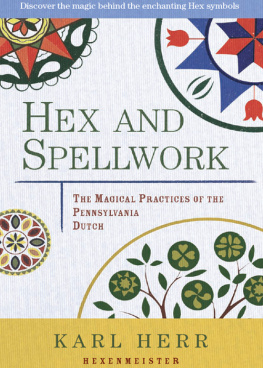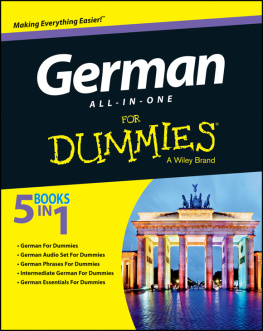A KEYSTONE BOOK
Keystone Books are intended to serve the citizens of Pennsylvania. They are accessible, well-researched explorations into the history, culture, society, and environment of the Keystone State as part of the Middle Atlantic region.
Library of Congress Cataloging-in-Publication Data
Names: Donner, William Wilkinson, author.
Title: Serious nonsense : groundhog lodges, Versammlinge, and Pennsylvania German heritage / William W. Donner.
Description: University Park, Pennsylvania : The Pennsylvania State University Press, [2016] | Includes bibliographical references and index.
Summary: Explores Pennsylvania German versammlinge (meetings), where participants celebrate and preserve their heritage and culture. Argues that these gatherings, conducted in the Pennsylvania German Deitsch language, are rooted in American communicative styles that date back to the late nineteenth and early twentieth centuries, before mass and electronic mediaProvided by publisher.
Identifiers: LCCN 2015038258 | ISBN 9780271071183 (pbk. : alk. paper)
Subjects: LCSH: Pennsylvania DutchSocial life and customs. | MeetingsPennsylvaniaHistory.
Classification: LCC F 160. G3 D66 2016 | DDC 305.893/10748dc23
LC record available at http://lccn.loc.gov/2015038258
Copyright 2016 The Pennsylvania State University
All rights reserved
Printed in the United States of America
Published by The Pennsylvania State University Press,
University Park, PA 16802-1003
The Pennsylvania State University Press is a member of the Association of American University Presses.
It is the policy of The Pennsylvania State University Press to use acid-free paper. Publications on uncoated stock satisfy the minimum requirements of American National Standard for Information SciencesPermanence of Paper for Printed Library Material, ANSI Z 39.481992.
Frontispiece: A large groundhog is brought into Groundhog Lodge #1, 1971. A man inside stops and chats with different people in the audience. Photo: Allentown Morning Call. All rights reserved.
Additional credits: show various years of program covers for Groundhog Lodge #1. Courtesy of author.
1. First meeting of Groundhog Lodge #1 in Allentown, February 2, 1934
2. Raad (board) of Groundhog Lodge #2 watching groundhog, ca. 1950
3. Ferbinnerei (Verbinnerei), oath of membership, Groundhog Lodge #1, 1972
4. Ferbinnerei (Verbinnerei), oath of membership, Groundhog Lodge #2, ca. 1955
5. Crowning the groundhog, 1968
6. Back cover of program for Groundhog Lodge #1, 1939
7. Rev. Rahn speaking at Groundhog Lodge #2, ca. 1944
8. Illustration from program for Groundhog Lodge #1, 1942
9. New Years Wish, Groundhog Lodge #1, 1943
10. Meeting announcement and invitation for Groundhog Lodge #1, 2011
11. Admission ticket for Groundhog Lodge #1 meeting, 2011
12. Taufschein (Daafschein), or baptism certificate, commemorating the first organizational meeting of Groundhog Lodge #1 in 1933
13. Pennsylvania German flag
14. Sign hanging at front of meetings of Groundhog Lodge #1: English Shwetza Is Ferbotta (Speaking English is forbidden)
15. Mounted animal scene from the front of speakers stand, Groundhog Lodge #1
16. Eight-foot-tall groundhog statue at the front of every meeting of Groundhog Lodge #1
17. Raad (wheel) listing the members of the board of Groundhog Lodge # 1 in 2015
18. View of meeting of Groundhog Lodge #1 at Germansville Fire Company, 2013
19. Schnitzelbank song from the back covers of Lodge #1 programs
20. Band at Groundhog Lodge #1, 2015
21. Procession bringing in a stuffed groundhog to be placed at the podium, Groundhog Lodge #1, 2013
22. The thirteen members of the Raad (board) of Groundhog Lodge #1, standing in front of the large groundhog, 2005
23. Ferbinnerei (Verbinnerei), oath of membership, Lodge #1, 2015
24. Program cover for Groundhog Lodge #1, 1958
25. Program cover for Groundhog Lodge #1, 1962
26. Program cover for Groundhog Lodge #1, 1965
27. Program cover for Groundhog Lodge #1, 1970
28. Program cover for Groundhog Lodge #1, 1979
29. Program cover for Groundhog Lodge #1, 1999
30. Rev. Rahn gives the main speech in front of a coffin for the goose, a weather-predicting rival of the groundhog, Groundhog Lodge #1, 1970
31. Women protest that they cannot attend meetings, Groundhog Lodge #1, 1973
32. Performers at Groundhog Lodge #2, ca. 1965
33. Local television crew interviewing Bill Meck, dressed as a groundhog, and Groundhog Lodge #1 leader (Haaptmann) Bill Williams, 2013
34. Doctor giving an injection during a skit, Groundhog Lodge #1, 2013
35. Groundhog being brought across the Jordan Creek, Lehigh County, 2013
I had a circuitous route to this project. Many of my ancestors were Pennsylvania Germans of one form or another. But I was raised in the suburbs of Philadelphia after World War II, and my relationship with Pennsylvania German culture was remote. Whenever I asked about my ancestry, my parents said that it was mostly German, Pennsylvania Dutch, or Pennsylvania German. My parents themselves were quite removed from the culture and people. Certainly none of us had ever heard of the versammlinge, the ceremonial Pennsylvania German meetings where only the Pennsylvania German Deitsch language can be spoken, or their most theatrical expression in the groundhog lodge meetings. As an adult, I listened for the first time to my mothers stories about her grandfather, who had been born in Womelsdorf, Berks County, shortly after the Civil War and migrated to Philadelphia as a young man to work on the railroad. She was raised in his house in Elkins Park outside of Philadelphia, and in her childhood she accompanied him on trips to Womelsdorf, in the heart of Pennsylvania German country. My mother probably told me about this throughout my childhood, but I never paid attention to any of it until I was in my late thirties and living in the Pennsylvania German region. When I was in my forties and well into learning about the Pennsylvania Germans, my parents also told me that when I was young we made some family trips to Pennsylvania German sites, including museums and folk festivals. I have absolutely no recollection of these trips. I assume that I must have been completely bored by the museums and events that I was seeing, as I was on other educational family trips.
There were a few mementos of Pennsylvania German heritage in my parents house. There was an old blanket chest, inherited from my great-great grandmother from Lebanon County on which my mother had painted some Pennsylvania German designs in the late 1940s, before I was born. There were passing references to Pennsylvania Germans in my schooldays, and a second grade Mothers Day class project, probably in 1958, when we painted a picture of a distelfink on bed trays for our mothers. I have a vague memory of hearing a family story about some ancestor who came to hate apple butter for her entire life because that was all there was to eat at some point in her youth. In my mothers kitchen there was a Scotch tape dispenser with a popular Pennsylvania German proverb on the side: We grow old too soon and smart too late. I also remember taking a group of friends on a trip through Pennsylvania German country during my college years; when we stopped by my parents house, my mother gave me a high school term paper that she had written in the late 1930s about the Pennsylvania Germans for us to read on our trip.




